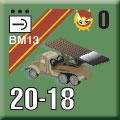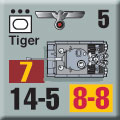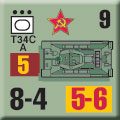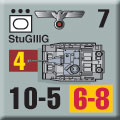| Kursk: Burning Tigers
Scenario Preview, Part One
By Mike Bennighof, Ph.D.
April 2023
 For the new Playbook edition of Panzer Grenadier: Kursk, Burning Tigers, we re-worked the scenarios into the chapter format of more recent Panzer Grenadier games, with battle games to tie together the scenarios in each chapter. That lets you, the player, string together related scenarios and play for an overall victory among them. For the new Playbook edition of Panzer Grenadier: Kursk, Burning Tigers, we re-worked the scenarios into the chapter format of more recent Panzer Grenadier games, with battle games to tie together the scenarios in each chapter. That lets you, the player, string together related scenarios and play for an overall victory among them.
Mike Perryman, the game’s original designer, did most of that re-organizing. He prefers a shorter battle game sequence than I usually craft. But in this case, most of the short ones (two or three scenarios) also have longer versions so you can play either way.
We originally published Burning Tigers in 2014, but memory claims that the design was on hand for several years before even beginning development. It arrived during a very bad time for Avalanche Press, and it took us a while to bring it to release.
Things are different now; a much-reduced overhead allows us to bring out more new books and games, and to re-visit older games as we reprint them and make upgrades and revisions.
Burning Tigers already had very good scenarios; the battle games, though, add a great deal to its play value. Let’s have a look at the first chapter of the new Playbook edition.
Chapter One
Army Detachment Kempf
Former Marine Werner Kempf commanded a detachment of three corps, including the III Panzer Corps, on the south flank of the German advance assigned to Army Group South. It would cover the right flank of II SS Panzer Corps’ drive northward toward Prokhorovka. He also had a battalion of Tiger tanks to support three panzer and six infantry divisions. If Kempf’s troops couldn’t keep up with the spearhead, the SS corps’ right flank would be vulnerable to attack from the strong reserves the Soviets had collected for just this purpose.
Scenario One
Tank Battle at Razumnoe
5 July 1943
 After a brisk artillery bombardment, five divisions of Army Detachment Kempf began assault crossings of the Northern Donets River. Once they had pushed the Soviets back from the river, the 6th Panzer Division and a Tiger tank battalion would exploit the opening and push northward to protect the flank of the main effort just to the west of Kempf’s front. At Razumnoe, Rudolf Schmidt’s 19th Panzer Division found the seam between two defending Soviet Guards Rifle divisions. After a brisk artillery bombardment, five divisions of Army Detachment Kempf began assault crossings of the Northern Donets River. Once they had pushed the Soviets back from the river, the 6th Panzer Division and a Tiger tank battalion would exploit the opening and push northward to protect the flank of the main effort just to the west of Kempf’s front. At Razumnoe, Rudolf Schmidt’s 19th Panzer Division found the seam between two defending Soviet Guards Rifle divisions.
Conclusion
As the engineers struggled to get the panzers across the river the grenadiers found themselves in grave danger of being overrun by the aggressive enemy armor. In response, the German soldiers began using the terrain to their advantage as small teams of grenadiers wielded Teller mines, flamethrowers, and whatever ever else was handy to hold the armor at bay. When the panzers arrived, it relieved the pressure on the grenadiers and enabled them to surge a mile forward, securing the bridgehead.
Notes
Whatever the game, Scenario One is played more than any other. So it’s good that we start off Burning Tigers with a very suitable Scenario One so we don’t have to break the chronological flow. This one will make a fine intro, with each side having a tank-infantry force of some size trying to force their way forward on a fairly narrow front.
Scenario Two
Tigers at Solomino
5 July 1943
 Hitler’s least-favorite general, Hans Freiherr von Funck, commanded 7th Panzer Division on the southern end of Kempf’s line. Funck’s division surged forward at 1300 hours and easily rolled over the first Soviet defensive belt. Following his orders, General A.V. Skvortsov of 78th Guards Rifle Division directed his attached armor reserves forward to halt the Hitlerite attackers before they could reach the second defensive belt. Hitler’s least-favorite general, Hans Freiherr von Funck, commanded 7th Panzer Division on the southern end of Kempf’s line. Funck’s division surged forward at 1300 hours and easily rolled over the first Soviet defensive belt. Following his orders, General A.V. Skvortsov of 78th Guards Rifle Division directed his attached armor reserves forward to halt the Hitlerite attackers before they could reach the second defensive belt.
Conclusion
The terrain lay flat as a billiard table, broken only by the occasional tributary of the Northern Donets and Razumnoe Rivers and the numerous small scattered villages. This environment greatly favored the Germans’ aggressive mobile doctrine, allowing them to herd the Soviets for 4.5 miles before halting operations for the night. The day proved a mixed bag for the 503rd Heavy Panzer Detachment as they claimed 34 Soviet tanks destroyed against no loses in tank fighting. However, minefields wreaked havoc as all of the 2nd Battalion’s tanks sustained damaged when they stumbled into a minefield.
Notes
A powerful German tank-infantry force, including a full company of Tigers, is on the attack against a well-fortified Soviet force, mostly Guards with morale equal to that of their attackers. Both sides have plenty of artillery, while the Germans get pretty hefty air support. This one is going to spill a lot of cardboard blood: there’s only one board in play so there’s no avoiding the action.
Scenario Three
Counterstrike at Koreniskaia
6 July 1943
 The Soviet High Command, Stavka, ordered an immediate counterattack once the Hitlerites became entangled in a defensive belt, hoping to destroy them while vulnerable. Responding to these directives, a sizable force assembled in the woods west of Koreniskaia Dacha waiting for the right time to strike. They couldn’t believe their luck when the enemy infantry arrived without any supporting armor. The Soviet High Command, Stavka, ordered an immediate counterattack once the Hitlerites became entangled in a defensive belt, hoping to destroy them while vulnerable. Responding to these directives, a sizable force assembled in the woods west of Koreniskaia Dacha waiting for the right time to strike. They couldn’t believe their luck when the enemy infantry arrived without any supporting armor.
Conclusion
At first the Soviets made good progress, but as they approached the Shevekino-Belgorod road things turned sour. The well-trained German infantry let the tanks roll over them and then put the enemy infantry to ground. The tanks continued on unsupported and ran into the arriving flak batteries and assault guns led personally by General Erhard Raus. Despite mounting casualties, the tanks doggedly pressed on until reaching the German divisional command post where assault teams managed to set the unsupported tanks on fire with gasoline. Even without proper coordination the Soviet attack had come within a hair’s breadth of success.
Notes
It’s just like the intro says: The Germans start dug in with no armor support, facing a powerful attacking force backed by lots of tanks. They will get a couple of assault guns and an 88mm battery, but the Red Army has plenty of tanks and no real concern about losing them. This will be another bloody scenario; all of that force is poured into just one mapboard.
Scenario Four
Fall of Melikhovo
8 July 1943
 Army Detachment Kempf bogged down and fell further and further behind schedule. With the stubborn defenders extracting a terrible toll from the Hitlerite invaders for each yard gained, it seemed unlikely that the attackers could reverse this trend. Nevertheless, Kempf demanded another try, and German military culture in turn demanded that they would obey or die trying. At the very least, the Germans needed to reach Melikhovo today. Army Detachment Kempf bogged down and fell further and further behind schedule. With the stubborn defenders extracting a terrible toll from the Hitlerite invaders for each yard gained, it seemed unlikely that the attackers could reverse this trend. Nevertheless, Kempf demanded another try, and German military culture in turn demanded that they would obey or die trying. At the very least, the Germans needed to reach Melikhovo today.
Conclusion
The Germans satisfied their commander’s demands by capturing Melikhovo, but they remained far behind schedule. The achievement of operational freedom of maneuver for the panzers required that the Lipouyi Donets River be crossed and the enemy near Belgorod be liquidated quickly. The Soviets had their own ideas about what was required.
Notes
Now we get to the big tank battles! It’s not quite a “throw every piece onto the board” battle, but it is a big one with plenty of armor. The Germans have a big edge in tanks, including two companies of Tigers and plenty of smaller ones. But the Soviets are dug in behind a belt of minefields, with the Germans facing a pretty tough schedule of victory conditions to win.
Scenario Five
Aggressive Defense
7 July 1943
 Once Operation Citadel started, Stavka followed a comprehensive and well-conceived plan of slowing down the attackers with prepared defensive positions. Once the Hitlerites became entangled in the defensive works the Red Army launched aggressive counterattacks with special attention paid to the defenders’ flanks. On the far southern flank of Army Detachment Kempf the Germans noted the significant Soviet buildup that had begun the previous day. Once Operation Citadel started, Stavka followed a comprehensive and well-conceived plan of slowing down the attackers with prepared defensive positions. Once the Hitlerites became entangled in the defensive works the Red Army launched aggressive counterattacks with special attention paid to the defenders’ flanks. On the far southern flank of Army Detachment Kempf the Germans noted the significant Soviet buildup that had begun the previous day.
Conclusion
The Germans planned for this sector to remain a quiet backwater. The Soviets upset the plan and stretched the meager assets of Group Raus almost to the breaking point with their numerous attacks over the last two days. Nevertheless, tenacity and ingenuity allowed the Germans, after much heavy fighting, to hold on without drawing on the armor spearhead to the north for support.
Notes
The Soviets are on the attack, with an infantry-heavy mixed force advancing on a narrow front. The Germans have very high morale and a very heavy allotment of support weapons, including some tank destroyers. Numbers favor the Red Army but the bar of victory is set pretty high.
Scenario Six
Dominoes Fall
11 July 1943
 Reviewing the first week of Operation Citadel, the headquarters staff at Army Detachment Kempf found agonizingly slow progress, with its 6th Panzer Division suffering the loss of over half of its armor. In one last desperate attempt to effect a breakout, Detachment headquarters ordered the 19th Panzer Division to assist 6th Panzer Division by advancing on the east bank of the Northern Donets River. They hoped that giving the Soviets two advancing forces on either side of the river would divide the defenders’ attention enough to overcome them. The Germans struck at the boundary of two Soviet divisions, their units intermingled as they fell back into new defensive lines. Reviewing the first week of Operation Citadel, the headquarters staff at Army Detachment Kempf found agonizingly slow progress, with its 6th Panzer Division suffering the loss of over half of its armor. In one last desperate attempt to effect a breakout, Detachment headquarters ordered the 19th Panzer Division to assist 6th Panzer Division by advancing on the east bank of the Northern Donets River. They hoped that giving the Soviets two advancing forces on either side of the river would divide the defenders’ attention enough to overcome them. The Germans struck at the boundary of two Soviet divisions, their units intermingled as they fell back into new defensive lines.
Conclusion
Adding a second panzer division to the attack finally moved III Panzer Corps forward. The 6th Panzer Division advanced six miles and secured Kazachie while 19th Panzer Division stormed through Khokhlovo, Kiselevo and Sabynino before halting for the night. The Soviets withdrew in some disorder; 96th Tank Brigade found itself abandoned by the infantry and temporarily isolated, but pulled out of German lines before the German noticed its predicament. Seventh Guards Army’s defenses had been damaged beyond repair, forcing that formation to send out a frantic cry for help that evening.
Notes
This one’s a pretty big scenario, with a tank-heavy German force assaulting a very well-entrenched Soviet defender backed by tanks and sporting many powerful anti-tank weapons (the 85mm anti-aircraft gun is not quite as awesome as the German 88, but it’s not far behind, either). The Germans have much more artillery at their command, but either side can see air support arrive. Things would get messy here if cardboard could bleed.
And that’s all for Chapter One. Next time, we dig into Chapter Two.
You can order Burning Tigers (Playbook edition) right here.
Please allow an extra three weeks for delivery.
Sign up for our newsletter right here. Your info will never be sold or transferred; we'll just use it to update you on new games and new offers.
Mike Bennighof is president of Avalanche Press and holds a doctorate in history from Emory University. A Fulbright Scholar and NASA Journalist in Space finalist, he has published a great many books, games and articles on historical subjects; people are saying that some of them are actually good.
He lives in Birmingham, Alabama with his wife, three children, and new puppy. He misses his lizard-hunting Iron Dog, Leopold.
Want to keep Daily Content free of third-party ads? You can send us some love (and cash) through this link right here.
|
